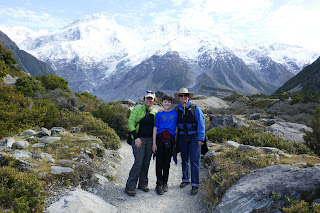 |
| Waka (boat) carving at the Aukland War Memorial Museum |
Over the last two weeks, we have learned about the indigenous people of New Zealand, or Aotearoa in Te reo Māori, from the extensive collection of art and artifacts at the Aukland Museum, a cultural education experience at the Tamaki Maori Village, at Te Puia in Rotorua, as well as extensive Māori interpretative signage at most of the sites we visited on the North Island and northern sites of the South Island. A lot, but only the tip of the iceberg.
Tamaki performer, in Rotorua
Just like in the U.S., Europeans did their best to systematically erase the culture of the indigenous people when they achieved control of the land. Children were beaten in schools for speaking their native tongue, as one classic and horrible example. Fortunately, attitudes and policies have changed, although one cannot erase scars from early mistreatment, and certainly racism persists. One sign of progress is that signage nearly universally has both English and Te reo Māori (recognized an official language of New Zealand in 1987), and in some places (such as in the museum) it is before/above English.
It is difficult to say anything about "the Māori" as a group, given that there are dozens of tribes, each with distinct cultural practices and traditions. It is my understanding that the Māori share language and many legends, which Jeremy discusses.
 |
| A carving in a whare whakairo (carved meeting house) in the Aukland Museum |
I have been struck by the maleness of the culture as reflected in the art: erect penises are a common theme, but I've seen almost nothing I recognize as relating to the female experience- no birth images, no babies, no breasts. This doesn't mean these things weren't important, only that they don't seem to be in representative art. While human figures are common, I have only seen two that were recognizably female (at a visitor center), and interestingly both included phallic symbolism.
Our feminist son was bothered by what he perceived to be a lack of equality of the sexes. In particular, he became upset when our Māori guide at the New Zealand Māori Arts and Crafts Institute told us that women were not admitted for carving.
 |
| A beautiful dress made by a woman, out of flax, at the New Zealand Māori Arts and Crafts Institute. Women are only admitted to do fiber arts at the Institute, in accordance with their tradition. |
 | ||
Jeremy observing a carver at the New Zealand Māori Arts and Crafts Institute
|
Here is the rest.
"What I Learned About Māori Culture in New Zealand"
by Jeremy Simon, age 10
The Māori are and were the
native people of New Zealand. They have many different customs, some disturbing
and some sensible. They also had many different stories about how things came
to be.
 |
| The Tamaki bringing baskets of food out of the cooking pits |
 |
| A feast, prepared in earth ovens |
Some of the other cool things that the Māori have are spiffy stick games and toys such as the poi. The poi is a rock or something such as a sponge (in modern days) attached to a string, with a knot or a tassel at the end of the string. You use a poi by swinging it around you in circular motions while looking really cool.
The Māori have many stories
about how things came to be. For example, there was a story about the South
Island of New Zealand. The Earth Mother and the Sky Father had kids.
Those kids
were sailing in their canoe to visit the Earth Mother when a terrible storm
struck. Their canoe flipped over, leaving them up on top of the canoe (trying
to stay dry). The rain from the storm was magical, and so it turned them all to
stone on top of their canoe. That stone is now the South Island. The sons are
now the highest mountains of the South Island.
Another story I have heard about
is a story about how some rock got to the shape that it did. The story is that
there was a giant, evil lizard. The lizard kept on coming back to terrorize a
town. It came back every single year and killed one maiden. But one year, the
maiden knew that the lizard was going to come for her. So she took up arms and
killed the lizard. She scattered his
scales everywhere with a single blow, turning them to
stone. The rock formations they say are the lizard’s stone scales.
 |
| A Maori wood carving in the Otago Museum |
 |
| Aoraki/Mt. Cook - the oldest son |
In conclusion, the Māori are a
very interesting people with many different customs and traditions. They also
had many interesting beliefs and stories.









No comments:
Post a Comment